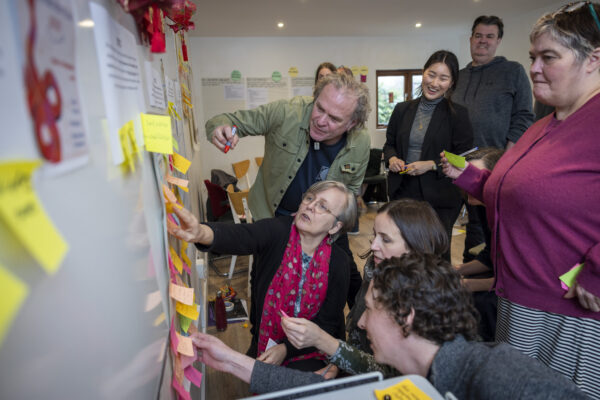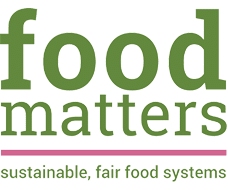Behind the day-to-day work of tackling food insecurity, improving access, and creating more sustainable local food systems lies something essential: how we connect, collaborate, and communicate with one another. Much of what makes a local food system work happens through relationship – links that are vital, even if they’re not always visible.
At Food Matters, we support partnerships and networks to map their community relationships and deepen their understanding of them through Social Network Analysis (SNA). Below, we explain what SNA is, and how we can use it as a framework to work with you to strengthen your partnership or organisation.

Photo credit – Andy Aitchison
What Is Social Network Analysis?
Every network is built on relationships—between teams, organisations, and individuals. Within a food system, this might involve food banks, schools, councils, and citizens, among others. Social Network Analysis is a way of network mapping these connections to provide a clear picture of how a network functions. It offers insight into:
Who is connected to whom
Where cooperation is already taking place
Where there might be opportunities to strengthen or broaden the network
Think of it as a reflective tool that helps you see your connections more clearly, guiding meaningful changes.
How we use Social Network Analysis
Our approach is straightforward and grounded in practical insights. Here’s how we typically proceed:
- Discovery
We start by taking time to understand your specific goals—whether you are addressing food waste, improving food access, or supporting healthy eating. This process means tailoring our work to suit your unique priorities. - Network Mapping
Using tools like Kumu, we create an interactive map of your partnership’s connections. This isn’t just a diagram—it’s a living resource that allows you to explore and better understand how your network functions at its core. - Insights and Action
We carefully examine your network map to highlight existing strengths, note any gaps, and point out potential areas for growth. From these insights, we offer simple and practical recommendations and work with you in small, focused sessions to put these ideas into practice.

Why does this matter?
Strong networks are at the heart of food systems that are healthy, sustainable, and fair. Social Network Analysis helps us work towards embedding strong networks in our food systems, by:
- Strengthening Collaboration: Identifying opportunities for better coordination and new partnerships
- Promoting Inclusivity: Ensuring everyone in your network has a voice and a role
- Uncovering Hidden Connections: Spotting connections you didn’t know existed
- Measuring Impact: Understanding how your partnership is making a difference.
We have worked with several local food partnerships in the UK using this approach, including:
- A partnership working on food security that discovered key players outside their usual network, which paved the way for new collaborative efforts
- A local authority used our method to see how their responsibilities spanned different departments, helping to create more effective, cross-departmental solutions
Want to see SNA in action?
Here is an example of social network analysis applied to a cross-sector food partnership that we worked with, helping to identify and strengthen their collective network by creating a visual aide for understanding the complex connections within it. Please note – places and names have been randomised to ensure anonymity.
Ready for your partnership to flourish?
With over 20 years of experience supporting food organisations and helping food partnerships flourish, we are uniquely positioned to help you organisations make the most of their networks
Our approach to Social Network Analysis is about more than data – it’s about deepening understanding and providing new perspectives that can help your partnership, organisation or network to achieve its goals and drive meaningful change.
If you’re interested in exploring how a clearer view of your network might help your organisation, get in touch below. We’re here to chat, listen, and work with you at your own pace.
Behind the day-to-day work of tackling food insecurity, improving access, and creating more sustainable local food systems lies something essential: how we connect, collaborate, and communicate with one another. Much of what makes a local food system work happens through relationship – links that are vital, even if they’re not always visible.
At Food Matters, we support partnerships and networks to map their community relationships and deepen their understanding of them through Social Network Analysis (SNA). Below, we explain what SNA is, and how we can use it as a framework to work with you to strengthen your partnership or organisation.

Photo credit – Andy Aitchison
What Is Social Network Analysis?
Every network is built on relationships—between teams, organisations, and individuals. Within a food system, this might involve food banks, schools, councils, and citizens, among others. Social Network Analysis is a way of network mapping these connections to provide a clear picture of how a network functions. It offers insight into:
Who is connected to whom
Where cooperation is already taking place
Where there might be opportunities to strengthen or broaden the network
Think of it as a reflective tool that helps you see your connections more clearly, guiding meaningful changes.
How we use Social Network Analysis
Our approach is straightforward and grounded in practical insights. Here’s how we typically proceed:
- Discovery
We start by taking time to understand your specific goals—whether you are addressing food waste, improving food access, or supporting healthy eating. This process means tailoring our work to suit your unique priorities. - Network Mapping
Using tools like Kumu, we create an interactive map of your partnership’s connections. This isn’t just a diagram—it’s a living resource that allows you to explore and better understand how your network functions at its core. - Insights and Action
We carefully examine your network map to highlight existing strengths, note any gaps, and point out potential areas for growth. From these insights, we offer simple and practical recommendations and work with you in small, focused sessions to put these ideas into practice.

Why does this matter?
Strong networks are at the heart of food systems that are healthy, sustainable, and fair. Social Network Analysis helps us work towards embedding strong networks in our food systems, by:
- Strengthening Collaboration: Identifying opportunities for better coordination and new partnerships
- Promoting Inclusivity: Ensuring everyone in your network has a voice and a role
- Uncovering Hidden Connections: Spotting connections you didn’t know existed
- Measuring Impact: Understanding how your partnership is making a difference.
We have worked with several local food partnerships in the UK using this approach, including:
- A partnership working on food security that discovered key players outside their usual network, which paved the way for new collaborative efforts
- A local authority used our method to see how their responsibilities spanned different departments, helping to create more effective, cross-departmental solutions
Want to see SNA in action?
Here is an example of social network analysis applied to a cross-sector food partnership that we worked with, helping to identify and strengthen their collective network by creating a visual aide for understanding the complex connections within it. Please note – places and names have been randomised to ensure anonymity.
Ready for your partnership to flourish?
With over 20 years of experience supporting food organisations and helping food partnerships flourish, we are uniquely positioned to help you organisations make the most of their networks
Our approach to Social Network Analysis is about more than data – it’s about deepening understanding and providing new perspectives that can help your partnership, organisation or network to achieve its goals and drive meaningful change.
If you’re interested in exploring how a clearer view of your network might help your organisation, get in touch below. We’re here to chat, listen, and work with you at your own pace.





